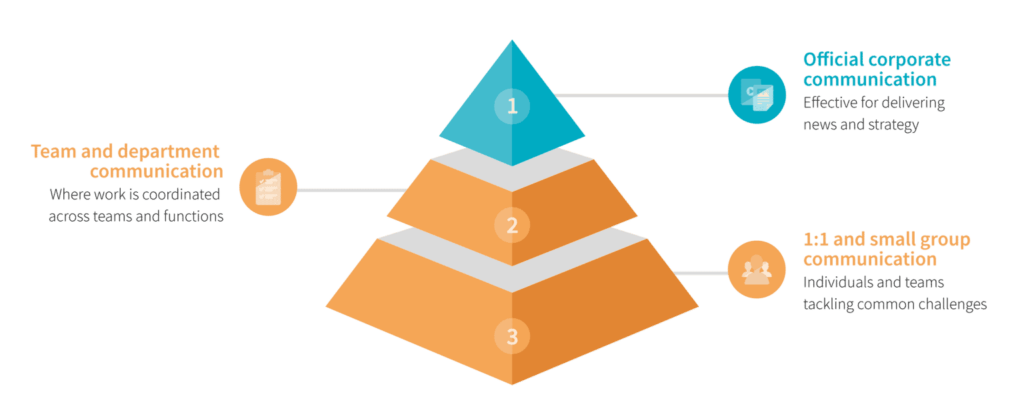The Complete Guide to Effective Team Communication

Let’s break down what team communication actually means. According to Merriam-Webster, communication is “a process by which information is exchanged between individuals through a common system of symbols, signs, or behavior.” In other words, it’s an exchange of information.
A team is a group of people “associated in work or activity.”
Putting the two together, team communication should be the exchange of information within a group of colleagues working towards a common goal.
Sounds pretty straightforward, right?
It is. But there’s also the potential for team communication to become miscommunication instead. Just because there’s an exchange of information doesn’t mean it’s always done effectively.
Miscommunication can:
- Lead team members to make assumptions and expectations based on wrong information
- Create closed loops and make some team members feel left out
- Lead to conflict about how information should be perceived/interpreted
Group communication becomes a lot more complex when you have so many opportunities for it to fail. We’ll be looking at ways to improve team communication later, but first, it’s important to understand why we want to improve communication in the first place.
Why Improving Team Communication Matters

Ask any manager if they’d like to improve group communication and team productivity and they’ll likely say: of course.
Who wouldn’t want their team to stay connected and avoid misunderstandings?
After all, improving team communication can have a ripple effect across all aspects of your business.
Good team communication has several benefits:
1. Identify and Resolve Conflicts Early On
Many internal communication problems within big corporations start as simple miscommunications or misunderstandings that become problems because they’re not dealt with early enough.
Maybe managers give vague requests and employees are afraid to speak up. Or, maybe employees simply aren’t well informed on what the company’s goals are. Tasks may get delayed or employees might feel disconnected from their roles.
Healthy communication means that both managers and employees can detect these issues early and solve them before they escalate.
2. Improve Employee Engagement
An engaged employee is one that enjoys their job and wants to offer value to the company they work for. A disengaged employee is not invested in their job and tends to do the bare minimum to keep it.
But why do employees become disengaged? Many times, it’s because of poor internal communication within the company. They may be disengaged because leadership is doing a poor job of communicating company goals. Or, they may feel like their feedback isn’t valued or noticed.
Employee engagement starts with improving team communication. If managers can encourage dialogue with their team, they can uncover why some employees may feel disengaged.
3. Encourage Bottom-Up Communication in Team Interactions
What exactly is bottom-up internal communication? It’s an approach in which employees at all levels within an organization contribute their feedback and ideas. It focuses on building communication channels that cross traditional hierarchies. That way, the information doesn’t just trickle down from leadership. It flows in both directions, and it gives frontline employees the opportunity to submit their ideas and requests.

Team communication isn’t a one-way street. When companies invest in improving team communication, they’re also opening up opportunities for bottom-up internal communication. They’re giving employees the tools to contribute their feedback and know that it will have an impact on company-wide decisions.
4. Build a Transparent Company Culture
When employees think that there is a lack of transparency and open communication in their work environment, they’re more likely to look for opportunities elsewhere (or, at the very least feel frustrated and burnt out).
Rigid hierarchies that restrict what information gets delivered to employees have no place in a transparent company culture. By improving team communication, companies can encourage open dialogue that breaks down those barriers between hierarchies.
Ultimately, transparent company culture supported by communication in team interactions creates trust between leadership and employees. Investing in the employee experience with tools that help employees stay connected and engaged is the first step in creating transparent company culture.
How Does Effective Team Communication Work?

There’s no one-size-fits-all when it comes to effective communication in a team. What counts as “good” team communication is more about managing different communication styles than following one particular strategy.
The first step to improving team communication is understanding the different ways people communicate effectively in the workplace.
These workplace communication styles can include:
1. Analytical
Those with analytical communication styles like data and detail. They want their decision-making to be backed up by concrete facts and figures rather than emotion-based arguments. Logical reasoning sways them far more than emotional appeal.
Because they tend to take emotion out of the equation when communicating, analytical communicators can sometimes seem detached. But they thrive in a transparent work environment where they can have access to as much detail as possible and they are able to see where data comes from.
Giving feedback for analytical types works best when it’s supported by numbers and figures rather than vague value judgments.
2. Intuitive
On the opposite side of the spectrum, those with an intuitive communication style take a big-picture approach and don’t like to focus on the nitty-gritty details when getting their point across.
People with this effective communication style are most likely to contribute creative solutions and think outside the box. They might not appreciate details and numbers like an analytical type would. Instead, they want to hear the “why” behind a project and how it fits into a greater strategy.
3. Personal
Those with a personal communication style are often seen as diplomatic and good at both spotting and resolving conflicts. They approach communication through the lens of emotion and personal connection and they’re good at picking up on non-verbal communication.
Because they excel in one-on-one interactions, they might struggle with working remotely, especially as more companies embrace WFH policies due to COVID-19. Strong team communication becomes particularly important in keeping them motivated and engaged while working remotely.
Leading with data isn’t going to sway a personal communicator as much as an emotional connection. Like the intuitive communicator, they’re more responsive when they know the “why” behind a project. In their case, it’s a more personal “why.”
4. Functional
Closer to the analytical communicator than the intuitive or personal one, the functional communicator loves a detailed, step-by-step plan. If anyone on your team goes into “what-if” mode often, they’re likely a functional communicator.
They want to know all the details about a project so they can troubleshoot anything that might go wrong. When they hear about a new idea, they want to know exactly how it’s going to be executed.
Functional communicators may seem like a killjoy to an intuitive thinker, who would be more likely to get excited about the big-picture implications. But people with this communication style are often the practical backbone of any team.
How to Improve Team Communications
Which one of the communication styles mentioned above resonates with you the most? What about the people you work with?
Understanding different team communication styles in the workplace can help us share information, collaborate more effectively, and improve team productivity. If we know that our colleague is an analytical type, we can come prepared with data. If a co-worker is more intuitive, we can focus on the big picture to get our point across.
Every team has its own unique dynamic. But what about how to improve communication on a company-wide level?
That’s where pairing a team communication tool with an internal communication strategy comes into play.
Improving team communications starts with choosing the right tools. And as more people are working remotely, companies rely on digital tools to help their workforce stay connected.
Here are a few tips on choosing and integrating team communication tools:
1. Rethink Your Current Communication Model

Switching to an entirely different communication tool or set of tools can seem daunting, particularly for companies with a lot of employees. How do you know if everyone will embrace the new tool? How can you be sure that the adoption process won’t slow down communication?
But even if employees are comfortable with using a certain tool, that doesn’t mean it’s ideally suited to how they work. While phone calls and email are perhaps the most basic way to communicate effectively in the workplace, some industries don’t benefit from going that route.
For frontline workers, email is not the best solution, given that they are almost always on the go and have limited opportunities to sit down and check their email. Choosing a frontline success platform like Beekeeper is a better option because it’s designed specifically for frontline workers. With Beekeeper, workers can get instant updates about shift schedules and safety information on their mobile devices without the need for an email address.
If your current team communication model doesn’t align with the reality of how employees actually work, it might be time to rethink the tools you’re using and search for a better solution.
2. Create and Distribute Communication Guidelines
Setting clear expectations for how you want employees to communicate effectively can seem awkward at first. Telling people how they should talk to each other can sound like you’re micromanaging your team.
But creating guidelines around communication skills in a team can help to prevent misunderstandings and make adopting a new tool a more seamless process. For example, specifying how often you expect team members to check into their team app can prevent them from worrying that they will miss an important update.
Or, if you’ve implemented a communication tool that facilitates file sharing, specify that it should be used for all client files. Otherwise, there may be confusion when employees try to send files by email instead.
3. Listen to Employee Feedback
Gathering and analyzing employee feedback can often fall lower on the priority list. But making time to get feedback is key to improving team communication.
This is especially true for remote or distributed teams. Because managers and workers are often not in the same location, managers can’t be expected to know the ins and outs of how their team communicates and any struggles they may be facing.
Feedback can come in the form of employee surveys, where you can ask questions focused on team communication:
- Do you feel like the tools you have allow you to stay informed about company updates?
- Are you comfortable communicating freely with colleagues and managers?
- Are there any expectations around communicating that you’re unsure about?
By getting feedback from employees, companies can adjust their team communication strategies to make it more effective, whether that means getting new tools or clarifying communication guidelines.
Best Practices for Cross-Team Communication
Teams don’t work in a vacuum.
Cross-team communication involves people with different backgrounds and communication skills sets coming together to solve a problem or achieve a shared goal. Achieving company-wide goals and healthy communication will likely require the expertise of people from different departments.
But there’s a lot that can go wrong in cross-team communication:
- People who aren’t used to team collaboration don’t know about the different communication styles of the people they’re working with.
- Deadlines might not allow enough time to develop team dynamics.
- To avoid ruffling any feathers, people can hold back some of their potentially innovative ideas and opinions.
Some best practices for improving cross-team communication:
Eliminate Siloes

The HBR study found that one of the main reasons why cross-functional teams fail was because of self-perpetuating siloes. Perceptions about how teams work together fuel how they communicate. And if those perceptions are negative, establishing team communication is an uphill battle.
“Designers and engineers don’t work well together” is a typical example. If teams go into working together with that idea, they’re already off to a bad start.
Celebrating cross-team collaboration wins on a company app is one way to break down these siloes and show that teams with different backgrounds can work together effectively.
Make Accountability Crystal Clear for Communication in a Team
One of the simplest reasons why cross-team communication fails is that people miss meetings. They prioritize their own team’s tasks over the tasks that make up a cross-team project. They just don’t show up.
That’s usually because cross-functional teams don’t have a clear accountability leader or hierarchy that oversees all aspects of a team collaboration project.
Assigning someone the responsibility to check that all members of a cross-functional team are actively involved can keep projects from getting delayed. And specifying who has the last word in making decisions can keep projects on track.
Establish Goals and Objectives Early On
Defining goals and establishing what success looks like might seem tedious or unnecessary for every project. But when adhering to specifications and staying aligned with company goals are two of the major pitfalls for cross-functional teams, it might be worth taking the time to do so.
One of the best practices of operational excellence is outlining broad goals as well as specific KPIs that will measure success. That way, team members can anticipate any conflicting priorities that would potentially prevent them from participating in a cross-functional team.
By having clearly-defined goals, objectives, deadlines, and resources before a cross-functional team begins working on a project, companies can avoid being part of the dysfunctional 75%.
Most Frequently Asked Questions
Why communication is important in a team?
Good communication enables to identify and resolve conflicts early and to improve employee engagement. In addition, it encourages bottom-up internal communication and can build a transparent company culture.

About the author
Beekeeper
We make frontline lives easier, work safer, and teams more connected so businesses can reach new heights. At Beekeeper, we’re dedicated to making frontline lives easier by connecting workers with the tools, support, and information they need to feel valued, do their best work, and drive the business forward.







